|
Aug 27, 2011 Reminiscing about the Internet 
I recently increased our Fiber port from 25/15 to 25/25. This should allow a little bit quicker access and/or heavier load to the servers. 
I can get speed through the firewall but I wonder if it can take any quicker as it is an old P3/700 1u Dell PowerApp with a slow bus. The good thing about that box is that it only draws 40 watts. That is less than anything else around here, so it is an energy efficient thing to be using. I believe the next firewall will have dual Xeon, gig ports and will sadly draw 200 or more watts and add an increased heat load on the cooling system. Progress I guess. So in updating my records I began to reminisce about all of our connectivity over the years and I started to dig. I had forgotten about some stuff and found it interesting. Looking back and seeing modem connectivity, for instance, which sounds lame or typical, but for 1994, routing an actual network across that before "web sites" even existed, it was kewl! So here is the list I came up with. 1997 is when sugarglider.com came to be. 1990 and before - dialup bbs, file transfer, commodore64 19910000 - 2400 ham radio packet digital 19920000 - Netcom shell account 19940000 - "www" World Wide Web is created 19940000 - 33k Dialup, Office, routing (30 ip), using office domain name to host personal pages 19960000 - 56k Dialup, Fastlane, routing (30 ip), moved personal pages to house 19970101 - 64k ISDN, Fastlane (30 ip), began hosting other peoples web sites 19970124 - registered sugarglider.com 19970308 - 128k ISDN, Fastlane Internet ISDN (30 ip) 19980810 - 128k ISDN, The Beam (30 ip) 19990318 - 2M MMDS Wireless 2-way, The Beam (30 ip) 19991110 - 128k ISDN, Unicomp, added first firewall with NAT and moved to name-based virtual servers (2 ip) 20000406 - 384k SDSL, Zyan (10 ip ) 20001005 - 384k/128k MMDS Wireless 2-way, Nucentrix Austin (1 ip) 20030501 - 1.5/768k ADSL, Speakeasy (2 ip) 20051024 - 15/2 FIOS, Verizon (5 ip) 20080724 - 20/5 FIOS, Verizon (5 ip) 20091007 - 25/15 FIOS, Verizon (5 ip) 20110816 - 25/25 FIOS, Verizon (5 ip) In addition to sugarglider.com, here are a few of the other domains I have hosted in the past: dogandcat.com stonetrail.com blackangus.com dfwbiz.com goldstarlimo.com englishworkshop.com davemathews.com rentanerd.com yeshello.com internetupdate.com onlineupdate.com It's fun to "remember when" especially when you have records of everything so you can be sure that you arent making things up. With technologies as they are today, it almost seems "modem-like" that we are only on a 25Mbps upstream. 100M ethernet seems old and slow. Yet with all of the really neat advancements, there is still a huge percentage of the Earth that has no Internet. There are those that would kill for a reliable 500k connection. Many of these people will experience the Internet for the first time on a wireless device and all of the history to get to that point will be lost to them. One thing that grieves me about technology is that it is built on top of itself. Those that "remember when" die off and nobody recalls how to make the original stuff. There may come a time when technology fails and there is nobody around that can rebuild it. Do you know how to make components, circuits, miniaturization, wave soldering, chips, software, power supplies, fabrication, metallurgy, wire making, power generation and transmission, codecs, communication protocols and endless other technologies... Imagine having to reinvent or duplicate that kind of stuff post-incident of some sort. Who do you know that can actually make as opposed to just use. Oh well, so our speed is up on the web site. yay!
Jul 6, 2011 Lost a boy today - RIP Spritz SugarShack I got home from a roadtrip Sunday night. A capable family member had been feeding the zoo for me for a few days without incident. This probably isnt related to the dead boy I found this morning in my cage of 8; yes, the extremely super tame and adorable colony. The cage has been smelling "shrimpy" for a day or two since I have been home. I did feed shrimp the night I got home so I ignored it until this morning when I decided to do a head count and check the bag. There I found one of the offspring boys. I believe it was Spritz from Momma Cookie as the remaining boy is smaller in size which fits with him being younger. I am unable to see any battle scars on anyone else and all seems fine except for that. It is possible that a fight broke out over food or such and the younger one lost. Being found in the bag suggests that he had a wound and then the colony probably began grooming on him to see him to his death. I suspect this all happened late at night to where nobody was around to intervene. Of course what I found is as sad a sight as you can imagine. It is one of the frightening things to come to know what these animals that we call our pets can do to their own. So with that sad thought I'll bid beautiful little Spritz a farewell and rest in peace with no idea why he had to leave us. He was almost 4. The Sugar Shack wont be the same without him. Sigh... 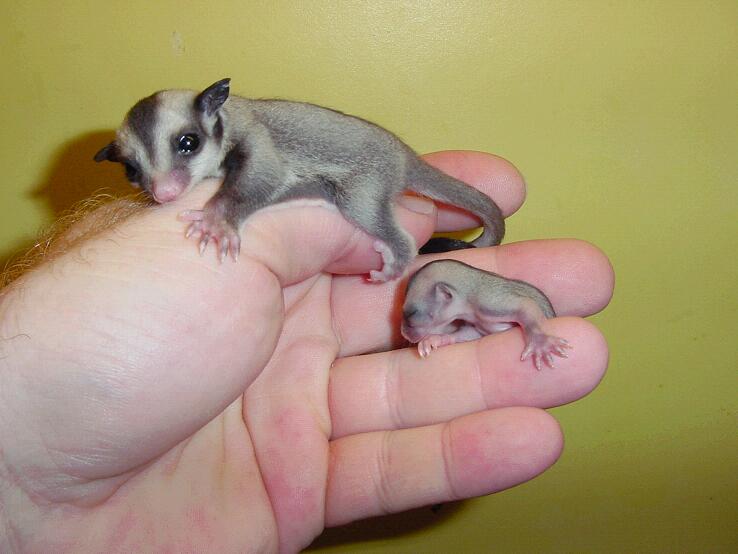
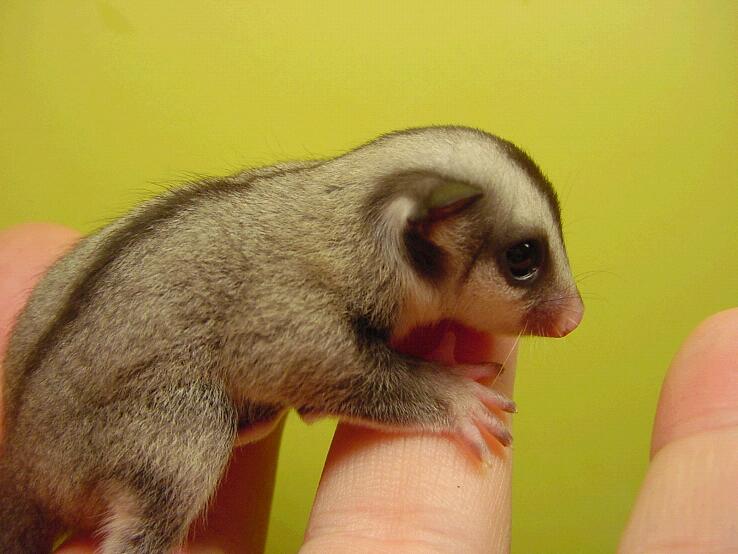
May 25, 2011 A better Mealworm Farm Update My current meal worm farm has been running well so I thought I would share what I am doing. I am still using the two drawer Sterelite with exhaust fan. see: A better Meal Worm Farm
Meal Worm farm Exhaust fan
The beetle drawer has a thin layer of cornmeal substrate and lots of vertical paper egg cartons for beetles to climb and lay eggs onto. You have to keep moist food (carrot, potato) in here so they have a water source and sustenance. The beetles dont eat the cornmeal substrate but the newly hatched tiny worms will. Perhaps every six weeks or so the baby worms will be of a size that it is time to move the farm forward. From the beetle drawer I dust off and remove all of the egg crates and then dump the entire contents into the worm drawer. The empty drawer gets cleaned and receives a new layer of cornmeal, the egg crates and every single beetle immediately picked out of the worm drawer as well as over the following weeks. The substrate in the worm drawer keeps growing as you dump the eggs in every six weeks. After around 6 months it may be time to clean out the worm drawer. This is the annoying process involving sifting that nobody likes. But using this method, you only need to do it perhaps twice a year as the continuously added substrate keeps the worm drawer usable. You do want to microwave your new layer of cornmeal for the cleaned out beetle drawer in order to kill off any chance of bugs. The beetles dont really need cornmeal so keep that layer thin so that it doesnt add much to the worm drawer each time. I personally feed both drawers with carrots, corn cobs, misc leafy leftovers such as lettuce, and on the worm drawer I will occasionally dump in leftover chicken bones with all of the unused meats, skin and fats left intact. The worms love this stuff and will eat the bones clean and then will also get inside and eat the marrow. Any cooked bones with marrow will be a welcome addition to your worm farm. Dont forget to date your drawers. I use white board markers to do this as it washes off. 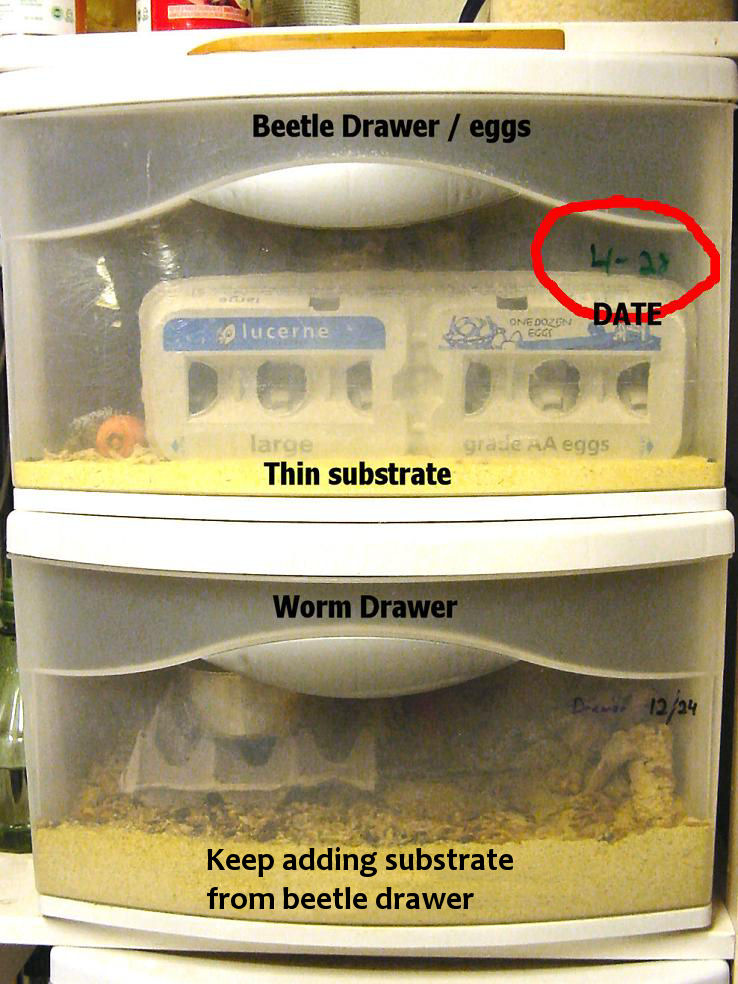
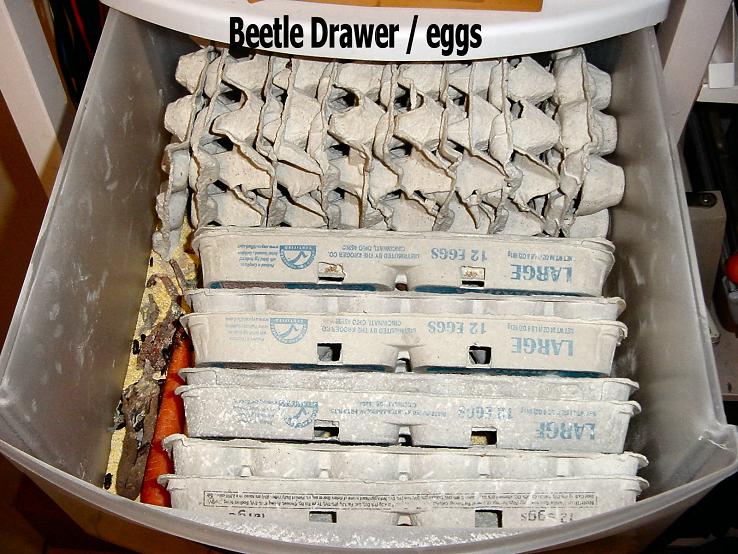
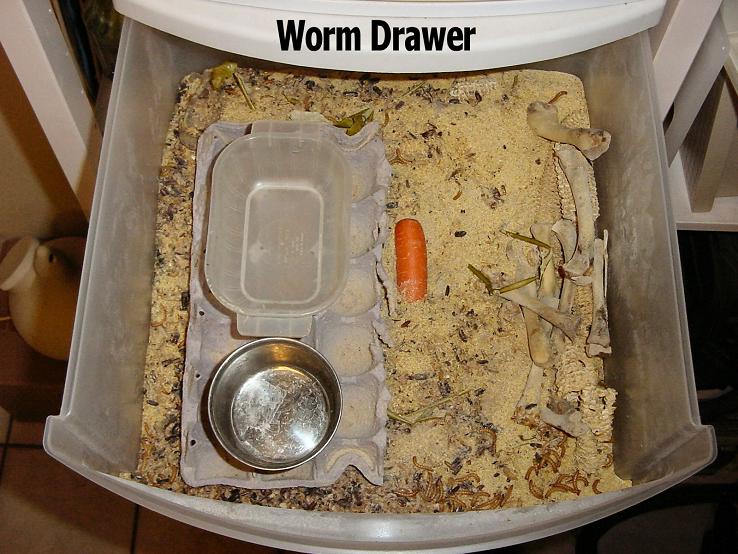
Jan 10, 2011 Musings on the infamous "wet method" A lot of people have been publicly flaming about this now infamous "wet method" for group introductions. The good news is that most of them are not long term keepers and they have no idea of what they are talking about. I don't mind if this discussion keeps on going. I think it is healthy if folks will stop flaming about it. Opinions don't matter, results do matter. I have found over my 14 years of keeping sugar gliders that they exhibit much more desirable behaviors in larger colonies. From what I have learned, this is as it should be in the wild. I believe that most American keepers probably have no experience with a large colony to be able to understand the nuances of what I am referring to. I am not your typical impulse buy sugar glider keeper. I have never carried my gliders around in a pouch. I have never taken them outside to play or to show to others. I dont baby them like so many others do. I keep them fed, clean, cared for, I interact with them when I can and I strive to give them the best life inside of a cage that they can have and that absolutely always includes being in numbers over 3 when possible. I also keep learning, experimenting and sharing as nothing is gained by operating "status-quo". Sugar gliders do not know what is best for them. If you are keeping them as pets, you are already changing their natural behaviors and are forcing things onto them without their will which absolutely includes interacting with you. Forcing a successful merging is no different than this. It is no different than daintily swapping pouches to force them to smell the other animals. It is no different than forcing them to be together to meet and pray that they choose not to fight. You know it is in their best interest to get along so why not use every tool or method that you can to make it actually happen the very first time and ease the stress of the entire procedure. This becomes a gain for them and for you. If you have a single glider and you add one, you will be amazed at the difference you see in both animals. Add a third and it gets better. Add a fourth and it gets better. And it just keeps getting better. The healthy interactions you see in a larger colony are missing in smaller groups. It is easier to breed a group if you are so inclined, but you can merge the groups as well using techniques that are all devised by people doing the experimenting. You cannot deny that every sugar glider will be happier with cage mates. Even the stubbornest of mean gliders can chill out and begin to have a happier caged life if you can manage a merging. Why not do everything you can for success? One of the only things that comes to mind right now that I have not tried is to use drugs to temporarily modify their behavior in order to force a successful merger. Why wouldn't you do that if it worked? If you can take a homeless sugar glider off of the street and give him a family that makes them all happier, why wouldn't you drug them for a week or get them wet to do it? These animals are not that fragile. They don't simply die when you move them to a new home as other people would have you believe. They can have health issues due to stress but only from long term issues, not from a moment of scare or from being cold or force held in order to trim their nails. In my experience with possums, opossums and learning about other marsupials, I think that sugar gliders are the most durable of the infraclass. They can survive the hottest of summers and the coldest of winters by using their natural colony skills. In Australia you hear about larger marsupials dropping out of the trees from heat stroke but you dont get much of that from sugar gliders because they are simply survivors. If you keep your animals healthy, forcing a merging on them is nothing but a joy in the end as they get to have more interactions in their dismal cage life. I have not yet been an advocate for this method but community upheaval at the idea of a few poor sugar gliders getting wet is absolutely ridiculous. So then yeah, I did it, I have been doing it for years, and I will always do it this way over other wasteful methods, because in my much more experienced opinion, it is easy for me, it is much easier for them, and it has been amazingly successful for me over the years and that is something you are just going to have to understand. I currently have 19 sugar gliders that were all given to me and they are in 3 cages. I have had so many more in the past and have found them new homes. I have stopped accepting "rescues" as it is too mentally draining on me. I have used this procedure on so many and the only thing that has ever resulted in it is happy and healthy cages of sugar gliders. So far in my sugar glider keeping career I have had one death here at my house and that was from an 8 year old obese female that I was given from a couple down in Louisiana who fed her mostly shrimp and apple and nuts. 25 days ago I merged 7 unrelated boys and they are doing so much better together than they were doing apart. There is no disputing that. No biting, no fussing, no wounds. Just try to show me something better, and you will find it is at the expense of your animals and probably of your own self. I think I'm doing a good job. What are you doing?
Dec 28, 2010 And then there were seven! Before she died, Susan asked me to care for her three neutered boys. This left me with an additional cage which was hard to find a spot for in this crowded house and it also divided attention that I can give everyone else. I had thoughts about attempting a colony merge but my other half disagrees with my methods and didn't support the concept for fear of the possible/probable dangerous outcome of seven misfit boys fighting. So I didn't do it. I have recently had several discussions with people who were having miserable outcomes while attempting mergings. I have successfully merged multiple animals in the past using this technique and it had never failed me. I stopped accepting new animals awhile back so I have had none to try it on for a long time. One recent cage cleaning day I saw a free weekend ahead and decided to give the 4 + 3 boys merging a go in order to build a larger colony of boys, drop a cage, increase attention I can give each colony and to ultimately test my old group merging procedure. CAGE1 was mine and had four second-hand boys that had all been previously merged using this technique. CAGE2 was Susan's and had her original one boy and then a pair she later got hold of and merged. The one was tame but the added pair were very skittish. My efforts paid off. It was a complete success. I could not have been happier with the outcome. The seven neutered boys are together with absolutely no fussing or fighting since day 1. The skittish pair are now out of the pouch early and are interacting extremely well with the group and with me. They all really do seem happier after the merging and that begins to question for me the idea of how many makes for a healthy keeping in a single cage. We all know that a single glider is a miserable glider and that two is always recommended as a necessity. I have always thought that one or two matings is an easy way to build your own single cage family colony at home with 4 to 8 animals. My own cage of 8 related animals is the most fun I have kept and now the 7 boys seem more full of life than the original separate 4 and 3. So I just wonder if a good number per cage would be 6 to 10. This has got to have been the easiest merging I have ever done, and I am not entirely sure of all of the reasons why, but the group merging procedure worked again and has avoided fussing, fighting and injuries. So it's a working colony cage full of second-hand misfits! PROLOGUE In order to offer another possible route to use if softer merging attempts have failed, I have decided to share my procedure with you, come Hell, high-water or flaming war. I don't think I have ever done this after trying "traditional" attempts so I cannot say if it will help at that point but it may still. The problem there is that sugar gliders have a very good scent memory. If they end up fighting with a new arrival, they remember the scent well and I think that ruins any future merging attempts. Also, I think that scent swapping pouches and things like that is more of a teaser than it is of a familiarization. In the wild, sugar gliders will steal a sleeping area. Obviously it will have a previous scent to it and they will defend against that old scent if it comes back. I don't think scent swapping is a good idea. This concept is why I devised the group merging procedure. It is designed to force them to fixate on other things besides the newbies, their smell, or any territorial or alpha issues. I have found that when sugar gliders are fixated, frightened, scared, threatened, whatever you want to call it, they will flock together for safety in numbers where they can. This immediately breaks down the normal smell and territorial barriers and allows the animals to become immediately socialized without the expected fussing, fighting or possible wounds which of course are highly stressful. PROCEDURE I use water and being wet as a fixation device. While fixated on the abnormal stimulus, sugar gliders are very much less interested in new smells and the fighting that comes with protecting territory. Instead, they focus solely on the abnormal stimulus, and in this case, all they want to do is get away from it. STEP1: Get em wet and then toss em together into a tiny cage in the shower and continue the stimulus of water. They will fixate on the threat of the water spritzing and being wet instead of each other. Keep them in this situation for over an hour. You can turn water on and off but I just kept it a very light spritz in order to keep them warm. They do need to be absolutely soaking wet. They will look miserable, but as they run around the tiny introduction cage, they are already interacting and are also merging scents. With no animals attacking, none are afraid of the others and your scent introductions are happening. After an hour or so when they slow down, appear worn out, or start to accept the situation, spray a healthy dose of scent mask on every wet bottom. I use mouthwash that may or may not be thinned out as I see fit. This will desensitize their noses and is an extra layer to allow them to come together without fussing. STEP2: Get them together. While they are still wet and scent-masked, offer a CLEAN/new pouch. They will all immediately scramble to get into it. You can now remove the little cage from the shower. They will find safety in the pouch away from the stimulus, they will groom themselves and also groom each other and will become worn out and go to sleep. Their scents will merge and their introductions will take. Immediately put them under a lamp and keep them like this in the tiny cage overnight to force them to stay in pouch. Skip this one night feeding to avoid introducing any food fussing issues and to also simply keep them in pouch socializing and normalizing scents. STEP3: The next day you can move them into a larger sized cage that is very open with only the same single pouch for retreat. The open cage allows them to get out and explore but they can constantly see each other so there are no surprises. Keep them in here for a few days to reinforce the merging. Keep an eye on them and be ready for any fighting, but with luck there wont be any. You can add in a couple exercise wheels as well for them to retreat to. STEP4: A few days later when you are comfortable with the idea, move them into the larger destination cage that has all amenities. You would be best served by using only the single pouch for awhile, but you can offer places to explore such as boxes and whatnot as well as multiple exercise wheels. You are done!
I know that nobody wants to see photos of sugar gliders suffering, but I have these here so you can see how this works and what has been surprisingly successful for me. The first step is to get them soaking wet and to keep them that way for awhile. It is what it is and it does various things to bypass their normal mental processes and it really helps the group merging. Wet boys running around 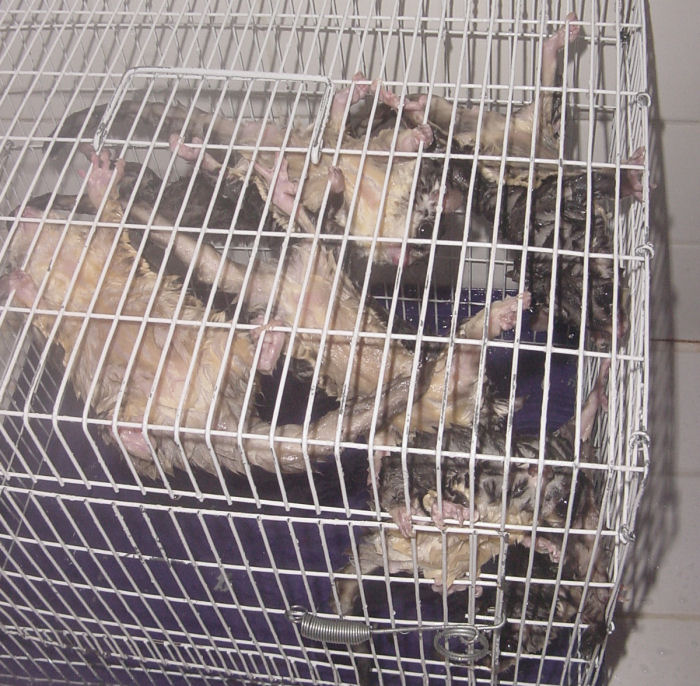
Wet boys now tired and mostly docile 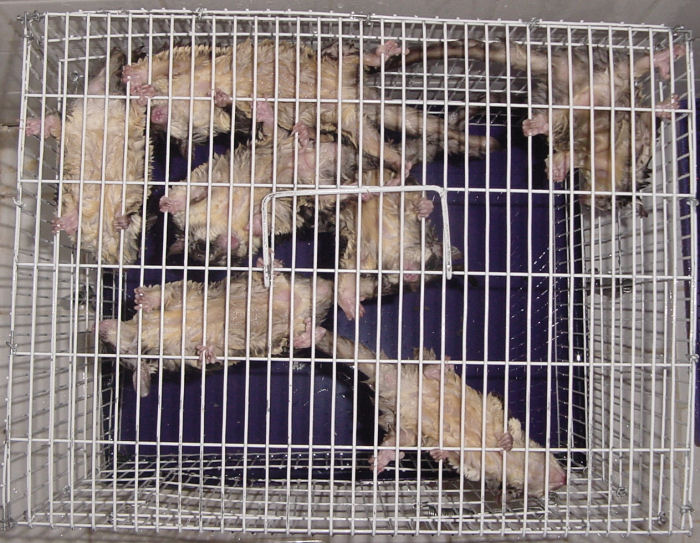
All scrambling into the new pouch 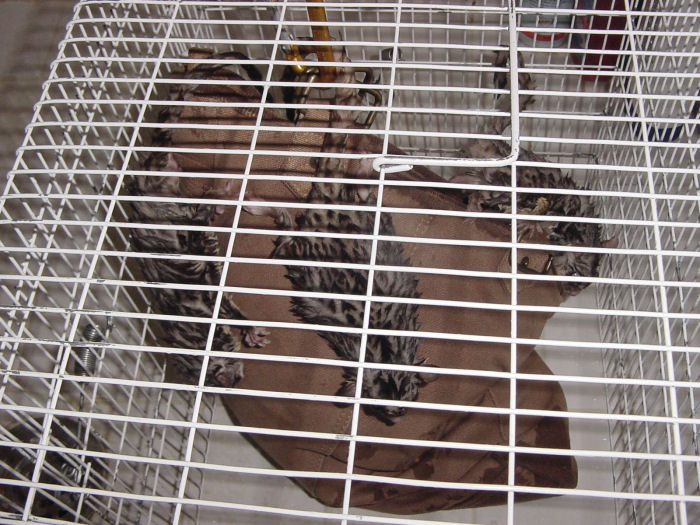
Desk lamp overnight to keep the boys in and docile 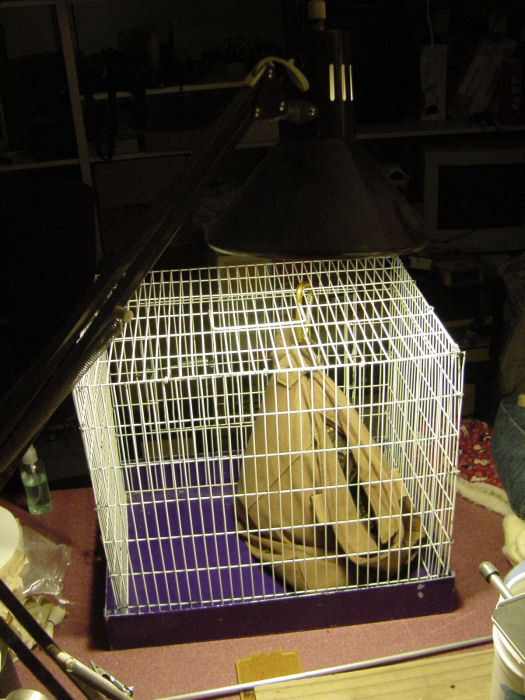
I decided to feed them in the morning since I'm a softie 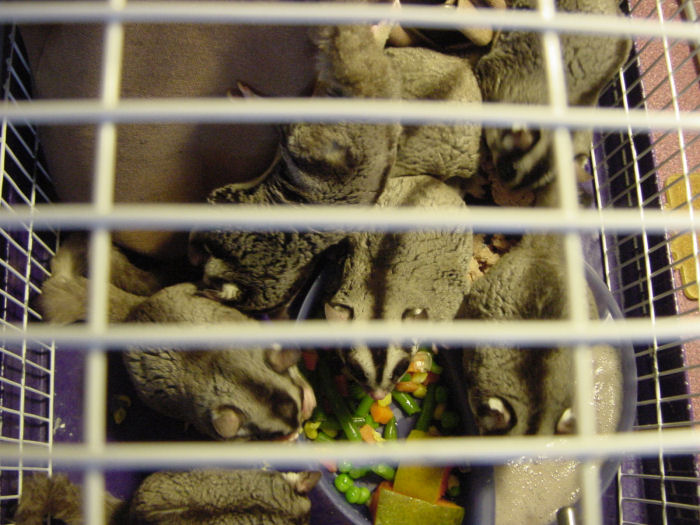
Not a single fuss 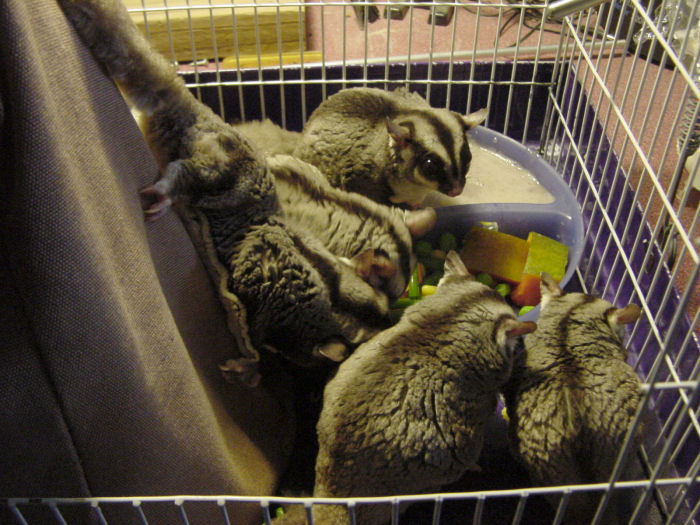
Medium cage for a few days 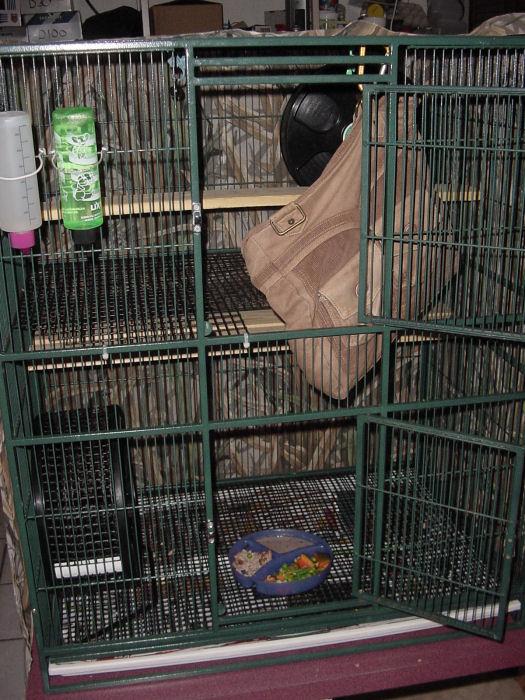
Seven happy and cozy boys 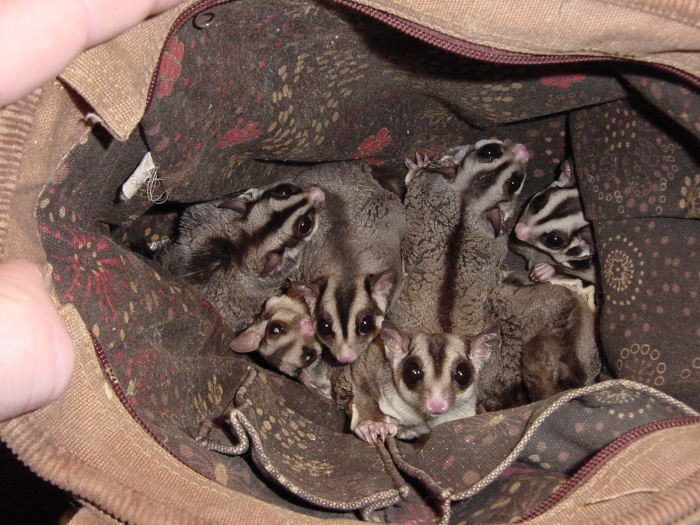
Large cage with stuff 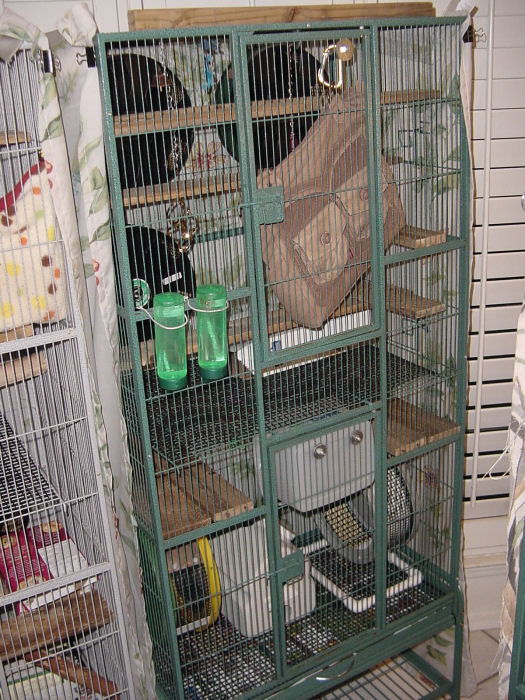
Dec 20, 2010 Trim Trax to trim track I am not a fan of Trim Trax for the Stealth. It didn't work on a cage of three boys. Their nails stayed evil sharp. Looking into the Trim Trax design, I found two things that I think fail. The first is simply that not enough force presses back on the nails to do any good. An attempt is made to correct that by lining the back of the sand paper with a plastic sheet, but it fails. Secondly, the tracks are held in place using small nylon bolts. The bolt heads stick up into the running surface which is never something you want to do. From the perspective of the animal, I think the bolts are capable of doing damage to the feet running on them, and at best, the animal has to avoid 8 bolts while running. When multiple animals are in the wheel, it is even harder to avoid the bolts. It is also a pain to maintain the tracks with 8 bolts and nuts to undo and redo. 





Modifying the Stealth to have a single solid nail trimmer track is very easy to do. All you need is a roll of 2-3/4"sand paper, some plastic hardware mesh
for the new inner track and a vinyl FRP trim strip
to cut out a track connector. Plastic mesh and an 8ft frp trim piece can be found at every Home Depot
. Cut an inner track from your roll of plastic mesh. Cut a similar length from your roll of sand paper
. 

Insert the sand paper into the wheel and then insert the new track into the wheel. 

Push the track as snug as you can inside of the wheel and then cut off any overlapping track leaving a small width for the track connector. 


Cut your track connector from the FRP trim, pull up both ends of the track, insert the connector then press it in and you should have a very firm running track which holds the sandpaper snugly in place. 



The new running surface is completely free from dangerous foot obstacles and it is 100% sand paper for a more powerful nail maintenance. 



This new design makes it very easy to remove the inner track and replace the sandpaper and it is all homebrew and off the shelf stuff. A single roll of sand paper will last you a very long time. Dec 18, 2010 Stealth wheel needs a trim track I inherited a Stealth exercise wheel from Snusie(RIP) along with her Three Amigos colony. The wheel came with those common two tack-on sandpaper strips to trim nails. The boys in this cage had some really mean nails so I dont think the strips were doing any good. I decided to upgrade the wheel to a full trim track and am writing this to show you how. All you need to do is to cut an inner track, cut a track connector, cut a length of sandpaper off of the roll and then insert all of it. There is no need to modify or disassemble the wheel. It is pretty easy and is no different a process on any of the wheels I have done this to. 



The 2-3/4" sandpaper roll can be purchased off eBay
. The track connector is cut from an FRP trim piece that you can get at any home store. You can read my previous post about doing this on the Wodent
. Oct 31, 2010 Meal worm farm exhaust fan In response to my previous journal entry A Better Meal Worm Farm
, I have been asked how to actually make an exhaust fan for a meal worm farm. You geeks out there probably dont need help with this but some folks actually dont own soldering irons or have donor computer junk handy, so for them, here it is. It took some creative searching but I finally found some usable product links to make this easy for you. All you need to do is choose any small computer cooling fan
that has the standard PC internal four-pin power connector as shown below, and then pick up a power supply
that has the same connector and that's all you really need. Im sure you can manage to figure out the rest. It is always a good idea to also cover the external side of the fan with a matching grill guard
to protect fingers or possibly curious sugar gliders. You can use your imagination and cut this into your box any way you please. You dont need a large fan or a strong one, it only has to slowly remove moisture. Those of us with soldering irons, skills and junk lying around might even end up using a lower voltage power supply on these or install a rheostat so you can pick a speed that works for your install. 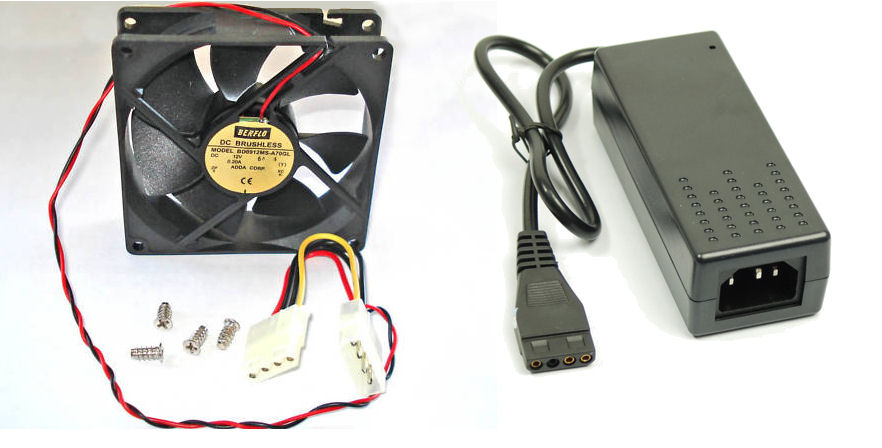
Oct 21, 2010 Sep 28, 2010 A better meal worm farm I have had a test mealworm drawer farm up and running for some time and I think now is a good time to share it. I chose the Sterilite
29 Quart drawer for a few reasons. The drawers need to prevent insects from easily gaining access so it needs to be enclosed; no open sides. I also wanted a deeper drawer so that I could stand egg crates up on their side to experiment with density as well as methods to keep the worms from climbing up into the egg crates; beetles only. 
I also wanted the ability to have multiple farms to try to time them at different points so that I always have worms. So I went with two drawers. They stack but not in a captive way, so I attached them together using rivets so that the weight of one drawer can hold the unbalanced weight of an open drawer. 

In my past experimenting I found that no matter what I tried, the farm got too moist, which inevitably leads to the "three M's": (Mold, Mildew and Mites). Some folks cut lots of holes to alleviate this but then you can get insects flying in. Some will also glue in small mesh screen but I have found that only keeps out the larger insects and not the really annoying gnats, fruit flies and whatnots. And even with holes, you are still relying on convection to move air and vacate moisture, so you really need inlet holes and a good design for that to even work properly. I did it differently and have found great results so far. I installed a small 12 volt computer fan pulled from an old power supply to exhaust air from the farm. This thing is installed on the lower part of the top drawer so that it can spread the draw across the back and sides of the drawer to prevent any specific high flow areas that might pick up debris. I also drilled a lot of holes between the two drawers so that the fan could draw air from below so that both drawers get exhausted. If i were doing only a single drawer I would have used a smaller fan, smaller voltage power supply or perhaps soldered in a potentiometer so I can adjust the speed. There is just enough opening above and around the front of each drawer to allow air to seep in while still blocking bugs. Any moisture or scent that might attract bugs is now only coming from the rear of the exhaust fan which makes it impossible for them to enter. An added benefit to this is that the constantly moving air makes the farm not smell. Nothing smells anymore, not even when I pull out a drawer to work on. 



Iterations of the project have taught me that there is absolutely nothing that can be done to automatically separate the beetles from the worms. If the beetles can climb, so can the worms. And strangely enough, I realized that both worms and beetles have a propensity for particular actions: the worms like to climb and the beetles like to dig. With this, I came up with something that has been working for me. First, I keep two egg crates in the worm drawer. The adult worms and fresh beetles tend to congregate on, in and under these things. The crates make it VERY easy to harvest mealworms for feeding, and they also make it easy to collect freshly hatched beetles to put into the nursery. After every harvesting, I will fully tap the crates clean of any debris so that they can collect a new clean batch of adult worms for next time. It has never been this easy.
Second, I keep a container inside the drawer with egg crate in it to allow the beetles to breed and lay eggs safely without adult worms trying to eat them all. The nursery is simply a smaller container that you keep in the drawer itself. I have been using square plastic ice cream buckets. Being in the main drawer allows the beetles to share the respired moisture created by all of the worms, and it makes it easier to service the farm. All you normally have to do is collect beetles one by one and drop into the nursery and then weed the refuse a little bit. I will take a drawer over to my bench to work on it. Every two or three days I usually first harvest a mass of worms for that night of treating, then I dust off the worm crates, collect beetles, weed the drawer and then finally feed. Dont forget to feed the farm. The beauty of the exhaust fan is that things no longer spoil the farm. It is easier to feed, but I still usually go with carrots and occasional lettuce and cooked potato leavings. Wet stuff just causes problems in a worm farm, so I choose the less moist stuff for feeding. Worms also seem to very much enjoy boring into spent corn cobs. 





Harvesting beetles is easy now. You simply pluck them off of the crate, lift the nursery and you'll find a bunch, and you can dig around a little in the substrate to get a solid feeling of completion. 

It is a good idea to make notes on the drawers themselves using a dry erase marker. I track when I cleaned out the drawer and nursery. 
Six weeks seems to be enough time to hatch some eggs and then dump the entire contents of the nursery into the worm drawer for a refresh. The worm drawer itself may last longer or shorter depending on what you do with it. I keep mine pretty well weeded but there does come a time when you need to clean it out. The good news is that if you clean the worm drawer just before you dump the nursery into it, you dont waste any small worms. All of the worms will be of larger size and they can be screened out easily. This makes the whole idea and process of worm farm drawer cleaning easier. |
|
About Me

kazko
Gender: Male Occupation:computer geek Member since: Jan 24, 1997 Posts: 6747  View my pictures! View my pictures! I'm on the map!
My Bio I'm on the map!
My BioNUTHOUSE (3)
Pican 4/30/2002, died 6/02/2010
Buddy 5/01/2006
Hazel 2/01/2007, rehomed 11/28/2011
Maya 4/25/2007
Pili 4/25/2007
MISFITS (3)
Big Guy 9/23/2003, died 1/29/2014
Lil Guy 9/23/2003, died 5/13/2015
Hunter 4/19/2006, died 3/23/2014
JP 8/12/2006
Shikoni 2004
Kioko 2003
Washi 2003, died 5/27/2014
SUGARSHACK (3)
Chico 1/15/2006, died 9/14/2011
Cookie 10/15/2005
Kimmie 10/15/2005
Lucky 5/25/2007
Spritz 8/24/2007, died 7/06/2011
Ginger 8/24/2007, died 12/16/2012
Rock 9/09/2007, died 3/23/2013
Crystal 9/09/2007, died 11/01/2012
|